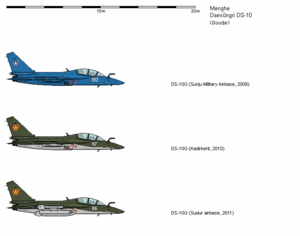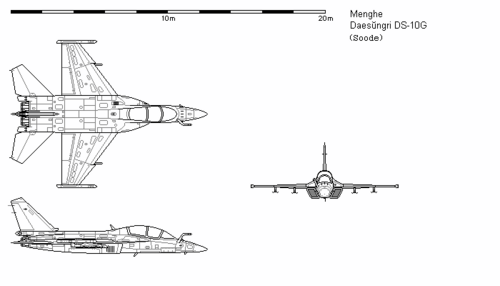Daesŭngri DS-10
| Daesŭngri DS-10 Chamsae | |
|---|---|

| |
| DS-11Gs in Navy (top) and Army (middle, bottom) training service. | |
| Role | Lead-in fighter trainer |
| National origin | Menghe |
| Manufacturer | Daesŭngri Aircraft Corporation |
| First flight | 2003 |
| Introduction | 2007 |
| Status | In service |
| Primary user | Menghe |
| Produced | 2006-present |
| Number built | 274 |
The Daesŭngri DS-10 (Formal designation: 대승리 10호 훈련기 / 大勝利一〇號訓鍊機, Daesŭngri Illyŏng-ho Hunryŏngi, "Daesŭngri No.10 Trainer Plane;" Short designation 대승-10 Daesŭng-illyŏng "Daesŭng-10"), officially nicknamed Chamsae (참새, "Sparrow") is a twin-engine trainer aircraft developed in Menghe during the early 2000s. It made its first flight in 2003 after a development period spanning the late 1990s and was introduced to service in 2007.
As an advanced lead-in fighter trainer, the DS-10 is meant to help cadets transition between propeller-driven ab initio and basic trainers and actual combat aircraft like the SR-8 and DS-9. The main variant, DS-10G also has a secondary combat capability, allowing it to be used as a light attack aircraft with limited self-defense capability. Its export variant, the DS-10JG, has improved radar and ECM equipment and is marketed as a low-cost fighter for small airforces.
Development
Menghe's interest in a new advanced trainer originated in the early 1990s, shortly after the country's economic opening. At that time, the mainstay of the Menghean trainer fleet was the DS-2N2, a tandem-seat variant of the Daesŭngri DS-2. While available in large numbers, the DS-2N2 had a number of shortcomings that limited its use as a trainer aircraft. Many of these problems stemmed from the DS-2's sometimes-temperamental engine, which could be challenging for new pilots to manage and was prone to failures after extended use. The in-line cockpit also left the instructor with a very limited field of view ahead, making it difficult for him to fly the plane directly if he had to take over. Accumulating safety concerns, some related to the engine and others to flaws in the airframe, contributed to an accident rate averaging two crashes per year in 1988 through 1996.
In 1993, Menghe attempted to address these problems by negotiating a purchase of thirty-six Hawk T1 trainer aircraft from New Tyran. Originally, the Menghean Ministry of National Defense planned to place additional orders, but met resistance from instructors who felt that the Hawk T1 could not adequately simulate the performance of newer fighter aircraft like the Songrim SR-8. The Air Force also came under political pressure to develop a domestically-built trainer, rather than relying on imported models from a non-allied country.
The Daesŭngri and Songrim aircraft design bureaus both began work on their own advanced trainers in the mid-1990s, with the latter opting for a cheaper subsonic jet while the former aimed for better performance. Daesŭngri's prototype made its first flight in 2003, impressing Ministry of Defense observers with its speed and agility. The Air Force soon adopted it for service as the Daesŭngri DS-10.
Design
The Daesŭngri DS-10 is specially designed as a lead-in fighter trainer, giving pilots their first experience flying a jet aircraft before they move on to operational conversion trainers. With this goal in mind, it is designed to simulate the performance of Menghe's other fighter aircraft, the Daesŭngri DS-9 and Songrim SR-8. It is one of a few trainers able to reach transonic and supersonic speeds. The fly-by-wire controls also allow the instructor to adjust the plane's maneuverability to more closely match the trainee's destination aircraft, or to reduce the risk of loss of control in early training.
Other fighter-like functionality comes in the form of glass cockpit for both the trainee and instructor, and a trainee heads-up display which can be programmed to simulate the HUD of any Menghean combat aircraft, including the DS-5M. To prepare trainees for combat aircraft, the DS-10's nose-mounted radar is capable of air-search, ground-search, and terrain-following modes, though its range in all modes is relatively short and it does not support radar-guided missiles. To further enhance training, the DS-10's onboard computers and datalinks can simulate targets and missile threats for multiple aircraft. Compatibility with the training variant of the Keikō HMD was added in 2017, further enhancing augmented-reality training.
Thrust is provided by two Mengjin TE-298 turbojet engines, each of which generates 4500 kilograms of thrust. These engines are equipped with afterburner capability, allowing the aircraft to reach speeds of Mach 1.3 in level flight at high altitude. In both wing loading and thrust-to-weight ratio, the DS-10 slightly outperforms the DS-9 and SR-8, allowing it to simulate the performance of either aircraft with adjustments to the programmed fly-by-wire system.
Internal fuel capacity is 2,000 kilograms, and this can be more than doubled with the addition of three 800-kilogram capacity drop tanks. The Chamsae also carries a non-retractable refueling probe on the right side of the nose. This feature, in addition to extending range, allows pilots to gain experience with probe-and-drogue refueling.
In times of war, the DS-10 can be pressed into service as a light attack aircraft. It has a total of seven hardpoints: one on each wingtip, two under each wing, and one under the fuselage. The innermost hardpoints under each wing are rated for loads of up to 1000 kg each, and are plumbed to support drop tanks, while the centerline hardpoint can be used to mount a Maenun targeting pod. A GP-24 revolver cannon in the left-side wing root provides organic gun capability, eliminating the need for a separate gun pod, though heavier gun pods can be mounted to augment firepower.
In its base variant, the DS-10 has only low-grade radar-lock warning equipment, and no jamming equipment. If flown in a high-threat environment, it requires dedicated ECM pods mounted on its external hardpoints, usually the "2" and "6" positions. Chaff and flare dispensers can be mounted at the base of the tail.
The single-piece tandem canopy is hinged, and opens to the side. Both the trainee and instructor have zero-zero ejection seats.
DS-10JG Stingray
The DS-10JG is a specialized variant which first appeared in 2013. It has a single-seat cockpit and an enlarged nose cone with an improved air-to-air radar system, allowing it to fire radar-guided air-to-air missiles like the YGG-7 Hwasal. It also has an aerial refueling probe, which the base variant lacks. Unlike the DS-10G, which is optimized for use as a trainer, variant "JG" is a dedicated multirole with no independent trainer capability.
Although neither the Army nor Navy have shown much interest in the DS-10JG, Menghe's Gunsu International Arms Export Company has marketed it abroad under the nickname "Stingray." The design is particularly promising for small, lower-income countries, as it is cheaper and easier to maintain than a large 4th-generation jet fighter. Because it is based on the DS-10 and retains many of the same internal systems, the DS-10JG also allows for faster training and streamlined maintenance for countries that also operate the DS-10G.
Service
The "Chamsae" was warmly received by trainees and instructors alike, and was a particularly distinct improvement over the aging DS-2HR. Pilots noted that the digital glass cockpit and heads-up display were much easier to work with than the old trainers' analog instruments, and that the DS-10's overall performance envelope was more forgiving for new pilots. The Army placed further orders, and the Navy ordered the plane for its land-based units. The last DS-2N2 trainers were retired in early 2019.
Currently, Menghean DS-10s serve within the 12th and 14th Training Wings, based in the Western and Southwestern Military Districts, respectively. These locations are relatively close to the militarized border with Maverica. If a major war were to break out, the Menghean Army could convert the 12th and 14th Training Wings into front-line formations piloted by instructors and reserve personnel, who would use them as ground-attack aircraft to support the Army's operations.
During the Innominadan Crisis, the Menghean Army did mobilize one regiment from the 12th Training Wing to support the Menghean intervention in Innominada. There, DS-10s flown by reserve pilots performed close air support missions from early October onward, after the Innominadan Army's air-defense capabilities had been effectively destroyed. The Chamsae gained a respectable combat record during this conflict, flying hundreds of sorties before the operational regiments were returned to training duties, but did not have the opportunity to prove itself against a parity opponent with fighter aircraft and an organized SAM network.
Variants
- DS-10G:
- Standard service variant used by the Menghean Army and Menghean Navy.
- DS-10N:
- Alternative configuration marketed for export alongside the DS-10G. It has a redesigned cockpit with the control stick on the right-hand side, to mimic the layout of the Rajian F-16 fighter. Because controls are fly-by-wire, this required no changes to the airframe apart from the layout of equipment within the cockpit.
- DS-10MGI:
- "Civilian" configuration with the gun removed, pylon attachments faired over, and radar downgraded to AN/APG-67. Mainly marketed to private buyers and airshow operators, though 10 were exported to Sebrenskiya in 2018 due to concerns that it would leak weapons technology to the Able Vigil Accords.
Operators
 Menghe: 268
Menghe: 268- Template:Country data Suurland: 50 ordered in 2010
- Template:Country data Ummayah: 24
Specifications
General characteristics
- Crew: 2
- Length: 12.54 m (41 ft 2 in)
- Wingspan: 9.41 m (30 ft 10 in)
- Height: 4.43 m (14 ft 6 in)
- Wing area: 24.52 m2 (263.89 ft2)
- Empty weight: 4,760 kg (10,470 lb)
- Loaded weight: 7,080 kg (15,610 lb)
- Max. takeoff weight: 11,230 kg (24,760 lb)
- Powerplant: 2 × Donghae 24/39 afterburning turbojet
- Dry thrust: 24.2 kN (5,440 lbf) each
- Thrust with afterburner: 39.6 kN (8,900 lbf) each
Performance
- Maximum speed: Mach 1.3 (1,380 km/h; 745 kts)
- Combat radius: 550 km (340 miles) on internal fuel
- Ferry range: 3,400 km (2,110 miles) with three external tanks
- Service ceiling: 14,800 m (48,560 ft)
- Wing loading: 288.7 kg/m2 (59.15 lb/ft2)
- Thrust/weight: 1.14 (clean, full internal fuel)
Armament
- Guns: 1× GP-24/3 revolver cannon, 110 rounds
- Hardpoints: 7 hardpoints with a capacity of 3,000 kg and provisions to carry combinations of:
- Missiles:
- Air-to-air missiles:
- Air-to-surface missiles:
- YGJ-43
- YGJ-45
- YGJ-47
- Bombs: Bombs up to 1,000kg (2,200 lbs)
- Other:
- Drop tanks:
- Drop tank with 800 kg fuel
- Drop tanks:
- Missiles:

